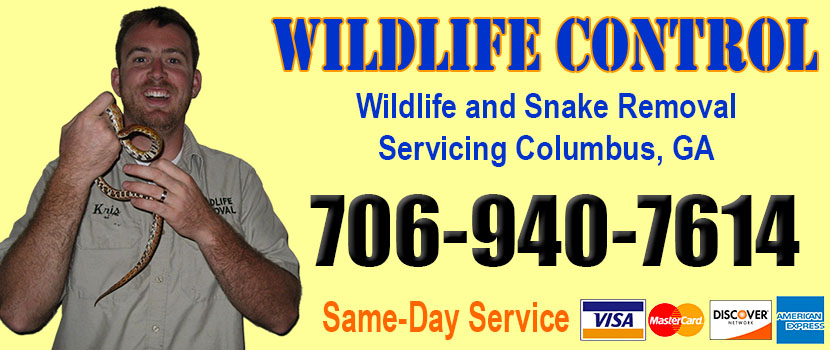
Welcome to columbusgeorgiasnakes.com! I am David, a snake enthusiast living in Columbus, GA. Many people don't know that Columbus is in fact full of snakes! You just need to know where to find them - they can often be shy and elusive. Some Georgia snake species are more common outside of the city limits, in different parts of Muscogee County GA, but many types of snakes are indeed common in the more urban parts of Columbus. This guide is meant to help educate you about the beautiful snakes of Columbus, and to help you identify the most common snakes of Columbus, as well as the venomous snakes of Columbus that you should learn to recognize and avoid. If you want more detail, click here for my complete list of ALL snake species in Columbus. Remember the following:
- Most snakes of Columbus are harmless and don't want to encounter you
- Venomous snakes exist but are uncommon in Columbus, Georgia
- Snakes eat rats and mice and are a valuable part of the Georgia ecosystem
- Never kill a snake - if you leave a snake alone, it will leave you alone.
Common Snake Species in Columbus
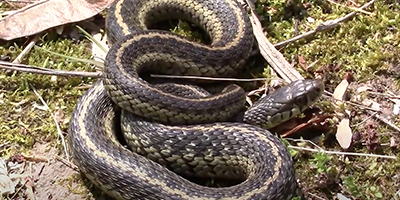 Eastern Garter Snake:
Eastern Garter Snake: Eastern garter snakes (Thamnophis sirtalis sirtalis) are harmless snakes commonly found throughout the east of North America. They rarely grow beyond 26 inches in length and are distinguished by the distinctive light garter stripe running down their backs. The rest of their body is a mix of greens, browns, and black. These snakes prefer a grassy or shrubby field. But will also be found in outbuildings or on abandoned farmlands. Mostly eastern garters eat toads, frogs, slugs, and worms. However, they’re not picky eaters: if they can catch it, they’ll likely eat it.
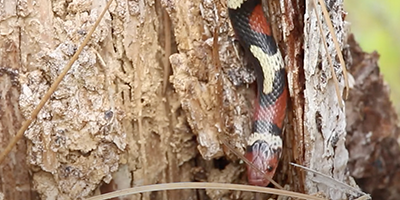 Scarlet Kingsnake:
Scarlet Kingsnake: In the pine forests, prairies, and pine-oak savannahs of the eastern United States, scarlet kingsnakes (Lampropeltis elapsoides) are readily spotted. Notably, for their vivid coloring, they are commonly mixed up with the venomous coral snake. However, their banding can be told apart. Scarlet kingsnakes have yellow bands surrounded by black and intervening red bands. Kingsnakes will famously hunt other snakes, but will also eat pests such as rodents. But these snakes are non-venomous, and so pose no threat to humans. Interestingly, despite being found inland, they are also excellent swimmers. They will grow to between 25 to 60 inches in length.
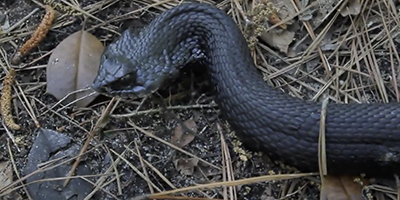 Eastern Hognose Snake:
Eastern Hognose Snake: Hognose snakes (Heterodon platirhinos) have an unforgettable appearance: a slim tail broadening to the thick, wide head. Their name comes from their upturned nose, which resembles a hog. This is used for digging in sandy soils. As a result, these snakes are not particularly aggressive. They are non-venomous and rarely attack humans unless disturbed. For the most part, they are a shy species and will stay in burrows. In appearance, hognoses are varied. Their coloring can include orange, brown, green, red, or even black. Their bodies can be a block color, blotched, or checkered. In length, they reach a respectable 28 inches, with the longest recorded eastern hognose measuring 46 inches.
Venomous Snake Species in Columbus
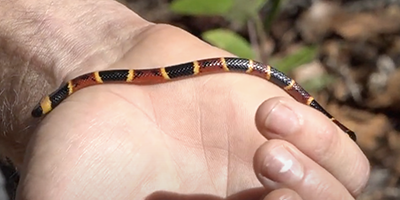 Coral Snake:
Coral Snake: Unlike the similarly patterned scarlet king snake, coral snakes (Elapidae) are venomous. There are many rhymes for remembering the difference, such as ‘Red on yellow kills a fellow. Red on black, venom lack.’ This rule holds for all species of coral snake. However, despite their venomous nature, coral snakes spend most of their time burrowing. Being elusive by nature, they venture out only to hunt and breed. Primarily they feed on lizards, frogs, nesting birds, small mammals, and other smaller snakes. In the US, they can be found in pine flatwoods, scrublands, and swamps. Although they avoid heavily populated areas, they do cause a significant proportion of annual snakebites. As these bites are incredibly potent, it is best to stay away from coral snakes at all costs.
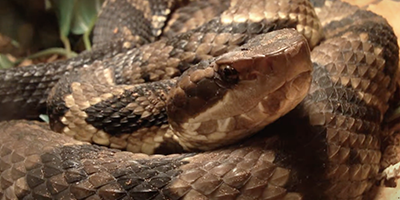 Cottonmouth:
Cottonmouth: Cottonmouths (Agkistrodon piscivorus), more commonly known as the water moccasin is a venomous snake associated with slow-moving water bodies. They are endemic throughout the south-eastern United States. As a water snake, they are powerful swimmers, capable of tackling open ocean. As such, their prey is typically fish or frogs. But they will eat anything they can catch, including other snakes, such as the hognose snake. It is their venom that poses the biggest threat. Being cytotoxic, it breaks down cells and tissues. Death is rare. But it can cause scars and even amputations. They are also highly aggressive snakes and will open their mouth wide when approached. But the chances of a bite are still rare. To spot them, look for dark coloring: olive, brown, or black. On their underside, there is a light banding that fades with age. But don’t get too close.
If you're unsure, you can email me a photo of the snake at info@columbusgeorgiasnakes.com and I will email you back with the snake's species. If you found a snake skin, read my Found a Skin? page, and you can email me a photo of the skin, and I'll identify the snake for you. If you need professional Columbus snake removal help, click my Get Help page, or see the below website sponsor I found, who provides that service.
Old Rhyme: Red Touch Yellow Kills a Fellow
This old poem was designed to help distinguish between the non-venomous scarlet king snake (in which black bands separate the red and yellow bands) and the coral snakes (wherein the red and the yellow bands are in contact. This rhyme has been existent for about 75 years and has undoubtedly saved many children from the experience of having to deal with a venomous snake bite.
Will This Poem Help Me Identify a Coral Snake?
We've heard some people who criticized the rhyme since they claimed it could not be applied in the entire country. Basically, those rhymes will be valid for those who live in the eastern section of the Mississippi River. Beyond the range of the coral snake, this rule may not be considered a comprehensive rule. The rhyme only described the standard type of snake. However, in some instances, the yellow bands will be missing on some coral snake species, making it difficult for you to determine the animal.
What Are Some Exceptions to this Rule?
If you move to the western section of the US, there will always be some exception to this rule, especially on some smaller snakes. Some of them include the shovel-nosed snake, sand snakes, and the ground snakes. In some tropical regions of the US, we will also encounter some snakes that share the same feature as the coral snake. For instance, we have the false coral snake whose red rings are touching the yellow rings. With this, there will be several situations wherein you may think that you are seeing a coral snake.
How Do I Know if it is a Coral Snake?
You can only find three types of coral snakes in the country; the average person may find them quite similar to each other. The best way to determine if you have a coral snake is to be aware of the range of the venomous reptile. If you don't live in the place where the Eastern Coral, Arizona Cora, and Texas Coral Snakes are found, chances are you have a scarlet king snake or other non-venomous animals. If you happen to see a coral snake in the wild, it would be best to leave them alone and admire their beauty from afar. Trying to catch them will put you at a higher chance of being bitten.
While there may be some exceptions, coral snakes would be best identified by their pattern. It is still better to rely on the old rhyme. You only have to remember some exceptions and if you are not too sure about it, avoid handling the snake. Also, there are instances when mother nature will produce some oddballs. Some animals may have a condition of hypermelanism or albinism, wherein their natural color can be altered. Unless you have profound knowledge about the snake, it can be quite easy for you to mistook these species for other snakes. Therefore, never attempt to handle them and allow the professionals to deal with them.
Remember, the term is not poisonous snakes of Columbus, it's venomous snakes of Columbus. Poison is generally something you eat, and venom is injected into you. That said, dangerous snakes are very rare in Columbus. The few venomous snakes of Muscogee County are rarely seen. But they are commonly misidentified, so learn about all the snake species of Columbus in order to correctly identify them. These snakes are usually also found in the surrounding towns of Buena Vista, Bibb City, Hamilton, Lumpkin, and the surrounding areas.
Read our article about:
What Are Some Effective Ways To Kill A Snake I Found In My Yard?
columbusgeorgiasnakes.com domain and hosting costs made possible by the generous support of this sponsor:
